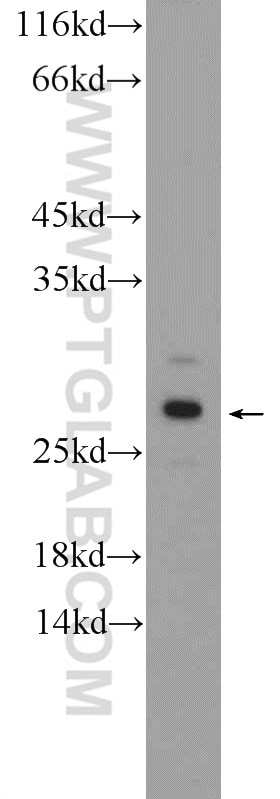Anticorps Polyclonal de lapin anti-AGPHD1
AGPHD1 Polyclonal Antibody for WB, ELISA
Hôte / Isotype
Lapin / IgG
Réactivité testée
Humain, souris
Applications
WB, ELISA
Conjugaison
Non conjugué
N° de cat : 26070-1-AP
Synonymes
Galerie de données de validation
Applications testées
| Résultats positifs en WB | tissu hépatique de souris |
Dilution recommandée
| Application | Dilution |
|---|---|
| Western Blot (WB) | WB : 1:500-1:1000 |
| It is recommended that this reagent should be titrated in each testing system to obtain optimal results. | |
| Sample-dependent, check data in validation data gallery | |
Informations sur le produit
26070-1-AP cible AGPHD1 dans les applications de WB, ELISA et montre une réactivité avec des échantillons Humain, souris
| Réactivité | Humain, souris |
| Hôte / Isotype | Lapin / IgG |
| Clonalité | Polyclonal |
| Type | Anticorps |
| Immunogène | AGPHD1 Protéine recombinante Ag23420 |
| Nom complet | similar to RIKEN cDNA C630028N24 gene |
| Poids moléculaire observé | 27-30 kDa |
| Numéro d’acquisition GenBank | BC132753 |
| Symbole du gène | LOC123688 |
| Identification du gène (NCBI) | 123688 |
| Conjugaison | Non conjugué |
| Forme | Liquide |
| Méthode de purification | Purification par affinité contre l'antigène |
| Tampon de stockage | PBS avec azoture de sodium à 0,02 % et glycérol à 50 % pH 7,3 |
| Conditions de stockage | Stocker à -20°C. Stable pendant un an après l'expédition. L'aliquotage n'est pas nécessaire pour le stockage à -20oC Les 20ul contiennent 0,1% de BSA. |
Informations générales
AGPHD1 encodes the 5-hydroxy-L-lysine kinase which catalyzes the GTP-dependent phosphorylation of 5-hydroxy-L-lysine. It is primarily present in liver and kidneys, suggesting its major role in degrading 5Hyl derived from food. Its presence at lower levels in other tissues indicates that it participates also in the catabolism of 5Hyl derived from local collagen breakdown.
Protocole
| Product Specific Protocols | |
|---|---|
| WB protocol for AGPHD1 antibody 26070-1-AP | Download protocol |
| Standard Protocols | |
|---|---|
| Click here to view our Standard Protocols |


